Dining Room Ideas — 23 Ways to Create a Stylish Modern Space to Gather
From simple storage to tasteful table decor, here's how designers curate the perfect convivial backdrop for dining
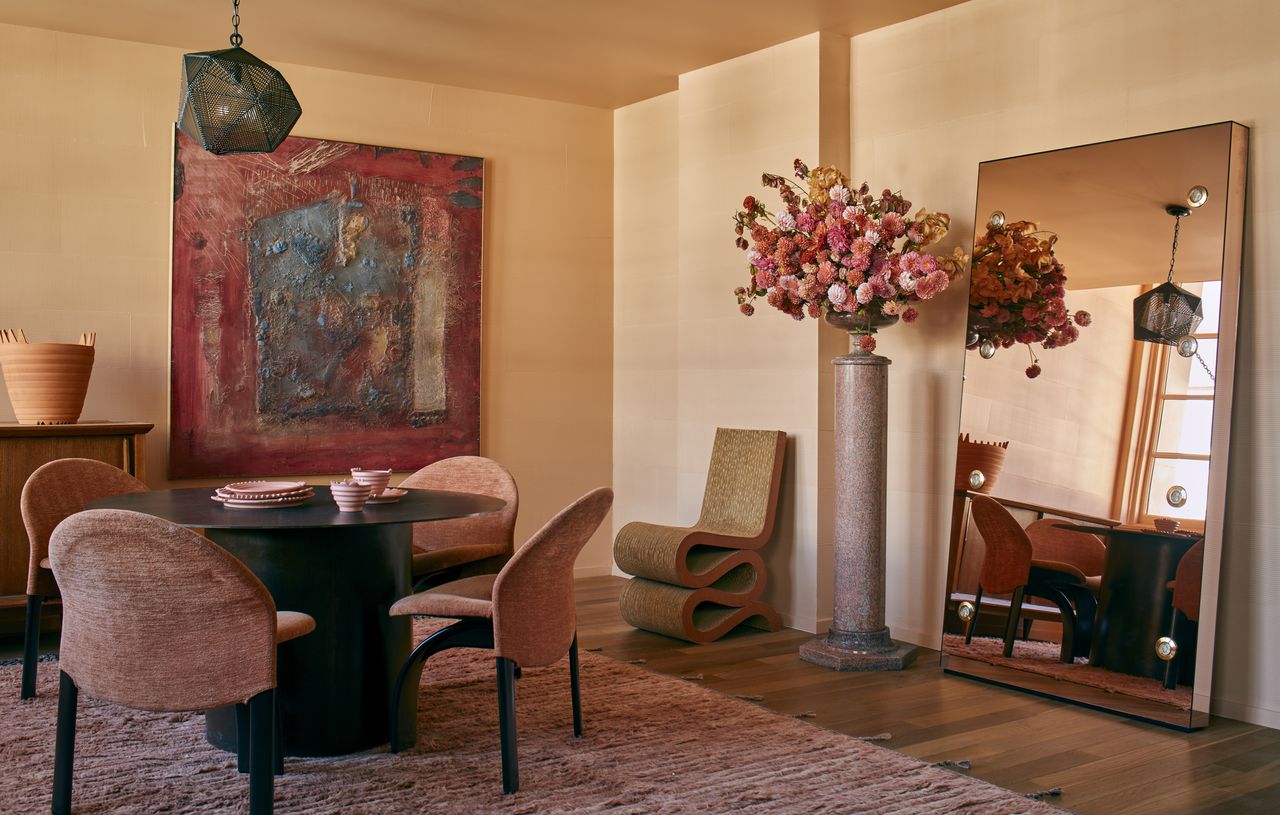
- 1. Color drench
- 2. Add a wall mural
- 3. Use Pattern in Soft Textiles
- 4. Choose statement lighting
- 5. Incorporate architectural details
- 6. Use mirrors to amplify space
- 7. Experiment with wall texture
- 8. Factor in function
- 9. Plan a lighting scheme
- 10. Don't forget the small decor
- 11. Anchor the room with color
- 12. Add a wall covering
- 13. Try a banquette
- 14. Or add a dining sofa
- 15. Fill with natural light
- 16. Use a sideboard for storage
- 17. Choose colorful dining chairs
- 18. Mix and match materials
- 19. Choose an all white color scheme
- 20. Embrace small with dark hues
- 21. Experiment with contrasting shapes
- 22. Add interest with a gallery wall
- 23. Ground with a rug
- FAQs

Hebe Hatton
When designing a dining room, it's vital that you marry form and function. They shouldn't only be practical spaces to gather and eat, but also a stylish corner of the home that makes an impression on guests. But besides a beautiful table and chairs, what else should you include?
With so many boxes to tick, from school night mealtimes to formal family gatherings, dining rooms can be tricky rooms to decorate, and it's easy to overlook the details. Unlike other areas of the home, however, going bold and brave can have a great payoff, especially if you have a separate kitchen diner meaning your dining room is reserved for special occasions.
"At a time when not a lot of families are 'formal dining' in their 'formal dining' rooms, I like to design dining areas that are comfortable, open, and reinforce the whole home design," explains Lucy Small, owner and lead designer at State and Season. "It shouldn’t feel like you’re locked away in a room just to eat, nor should it feel like you’re trying to get comfortable in an antique museum."
Be it bold wallpaper, statement chairs, or towering taper candles, there are so many design details that could benefit your dining room — even if you're working with a small dining room. To find out what elements designers are using, we've rustled up their best advice to get your dining room decor right.
1. Color drench for depth and drama
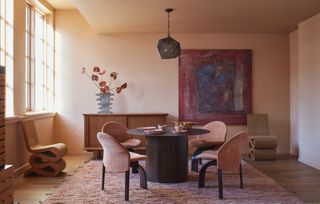
Gone are the days of drab dining rooms with stark white walls. To inject character into your space and truly make it a transportive mealtime rendez vouz, try color drenching. Pick a nuanced shade and encase the whole room — from doors to woodwork to ceiling and everything in between — and you'll have a space that oozes personality. It's also a great way to make a small dining room feel bigger.
"This creates an enveloping effect that can make a dining room feel intimate and bold," explains interior designer, Nina Lichtenstein, who urges us to choose a shade that reflects the mood we want to create. According to her, the best dining room colors are deep blues or greens for a sophisticated vibe, or soft pastels for an airy feel. "This monochromatic technique enhances both form and function, letting your dining room seamlessly merge with the rest of your home," adds Nina.
2. Add an exotic wall mural
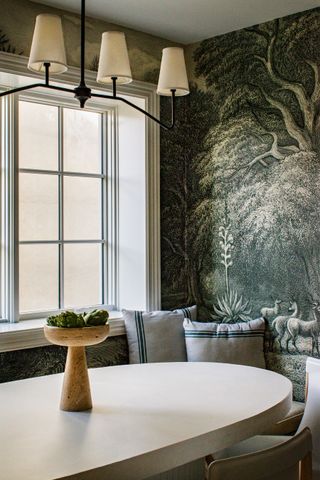
Is color not transporting your dining room to the exotic heights you want it to reach? Try an enchanting wall mural instead. Whether you decide to paint a beach-scape or you want to experiment with hand-drawn dining room wallpaper ideas, this is the place to do it. Unlike other rooms of the home, it's not somewhere we spend a great deal of time, so a bold feast for the eyes can make a great statement without feeling overwhelming.
"Choose a scene or abstract design that reflects your style, such as a serene forest landscape for a nature-inspired space or a modern geometric design for a more contemporary look," suggests Nina. "Murals not only add visual depth and intrigue but also serve as conversation starters, bringing artful charm to your dining experiences."

Priced from: $428
Combining trends for frescoes and black-and-white scenes, this design from Woodchip & Magnolia is punctuated with accent butterflies in color that make for focal points in the design.
3. Introduce Pattern Through Soft Textiles
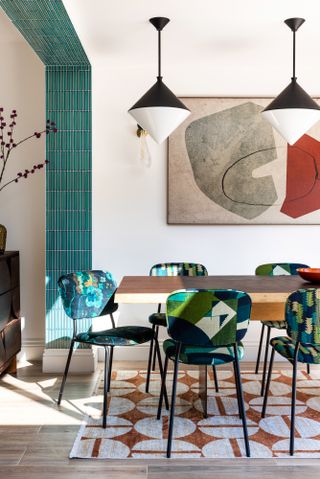
Dining rooms are spaces ripe for experimentation, so maximalism can really pay off. In the design above by Studio Enass, it's all about the pattern clash: the chairs, rug, artwork, and tiles are all statement pieces tempered by a neutral backdrop. Since soft textiles are usually minimal in dining rooms, they offer perfect spots to pepper with playful patterns, offering a point of visual interest and making for a more cozy dining room idea.
"We wanted to create something that was playful and fun yet sophisticated for this dining space," says interior designer and founder Enass Mahmoud. "The white walls gave us the opportunity to splash color and pattern into this room without being too overwhelming. Even though we used three different fabrics for the dining chairs, they were still from the same color scheme, which also complimented the window dressing."
4. Choose statement lighting as a focal point
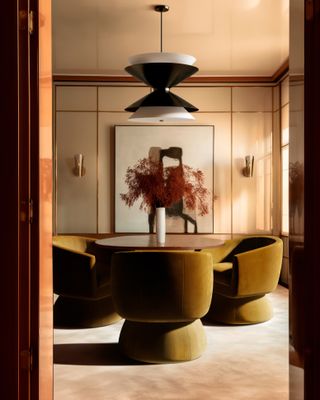
"I also love using a dramatic light fixture that acts as jewelry or art. Sconces are perfect to accent art on the walls or flank a buffet or hutch. Lightweight, billowy drapery (layered with sheers if possible). Ceiling details (trim, interesting crown molding, or even paint or wallpaper)," says Sabrina Albanese of Sabrina Albanese Interiors.
"Lighting sets the tone for your dining room, and a statement light fixture can act as a captivating focal point. Go for a chandelier or oversized pendant that complements your decor style, such as a brass sputnik for mid-century modern flair or a rustic candelabra for a cozy farmhouse touch. Layer with dimmable wall sconces or table lamps for added ambiance, giving you control over the mood for any occasion." Nina
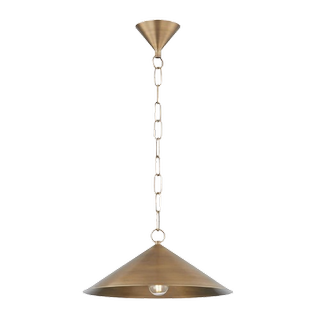
Price: $300
Chain link pendants add a really intriguing touch, especially when the same metal finish follows through to the shade, too. Hang a duo of these pendants above a small island or breakfast bar for a classic look.
5. Incorporate architectural details
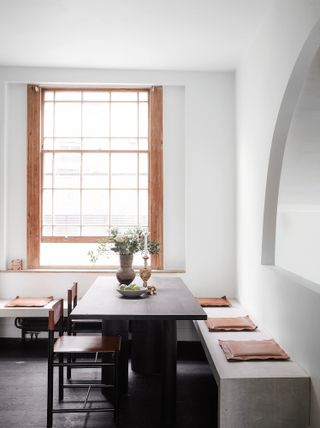
The best dining room ideas are those that incorporate the key features of the space and enhance them — particularly when they're as architecturally stunning as this scheme, which belongs to jewelry designer Rosh Mahtani of Alighieri and her partner, designer Fred Rigby. It features a bespoke concrete bench that wraps around the table, and whose sharp edges contrast with a large arch above.
Incorporating your dining room seating into an alcove or corner, instead of relying on dining room chair trends, is a great way to achieve a similar effect, as it will help highlight these interesting elements of a room — and can maximize space, too. Also, pay attention to windows: particularly beautiful designs with spectacular stained glass or paneling, if you're lucky enough to have them, can act as artwork when a dining table is positioned directly underneath.
6. Use mirrors to amplify space and light
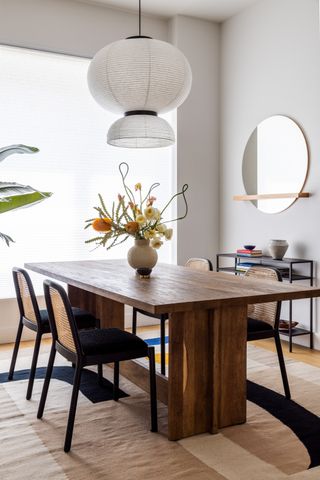
By reflecting the room, mirrors have the power to dramatically maximize a space, something that's especially useful in small apartment dining room ideas. If space is at a premium in your eatery, a large mirror on the wall will work wonders.
"Hang an oversized mirror on one wall, or create a gallery wall of smaller mirrors in various shapes and frames for a more eclectic look," says Nina. "Mirrors work especially well in dining rooms with limited natural light, amplifying what light there is and enhancing the room’s ambiance."

Price: $369.99
For a contemporary feel, asymmetrical mirrors are the way forward. And in a room such as a dining room where they don't serve such a practical "vanity" purpose, you can be more experimental with the shape.
7. Experiment with wall texture
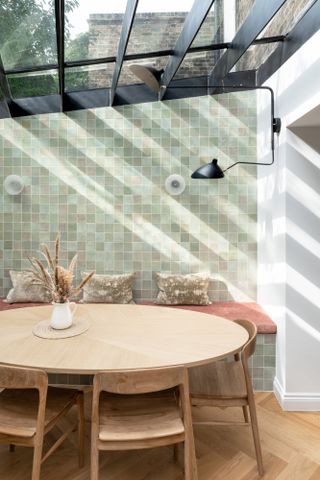
Look beyond beautiful but well-used ideas like paneling in your dining room and opt for something a little more surprising for your walls instead. With so many wall textures available, this surface is ripe for experimentation — and as a dining room isn't prone to the same wear and tear as spaces like kitchens, bathrooms, and hallways, you can afford to look to ideas like plaster, high gloss or even upholstery to add interest to your scheme.
"I am super obsessed with grasscloth papers and papers that emulate amazing textural finishes like stone, clay, or fabric," says designer Abigail Ahern. "These texturized papers add so much coziness to a space. Easy, elegant, and yet compelling and intriguing to the eye."
If your dining room is part of a larger kitchen, however — or if you have very messy small children — then a more practical but still interesting solution is tiling, like this example from London-based MW Architects. Removed from their usual spots in kitchens and bathrooms, they're an unexpected addition to a dining room that can add color, texture, and contrast — while being easy to clean, too.
8. Factor in function
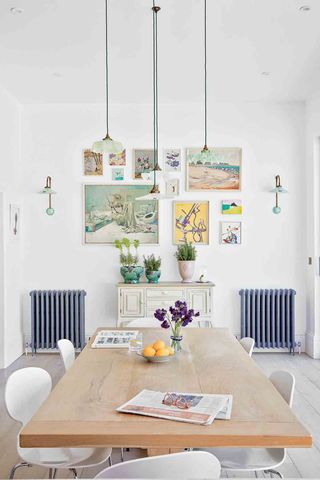
It’s tempting to concentrate on just the look when you’re designing a dining room idea. However, you need to think practically too. Before choosing furniture, layouts and decor, Clotilde Passalacqua, interior design manager at Ikea, says you should consider if your dining room is more for everyday use, or if it will be reserved for hosting dinner parties. "You’ll need to organize the space to meet individual needs," she says.
Also, think about whether your dining room doubles up as a workspace during the day. Does your furniture, therefore, need to be comfy enough so you can sit over a laptop for a few hours? If so, you might also want to consider not going too bold with the decor, as you don't want that to be a distraction.
However, if the sole use of your dining room is for just that — dining — then we say go as bold as you dare. So before starting your dining room mood board, pull inspiration from your favorite restaurants and bars to help design a space that's made for entertaining.
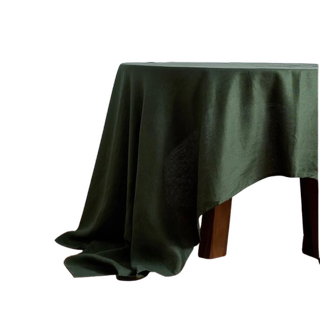
Price: $120
If you'll be frequently using your dining room for dinner parties, a linen tablecloth like this one will instantly elevate your setup. Choose rich colors, like this olive green, for an elegant and sophisticated atmosphere.
9. Plan a nuanced lighting scheme
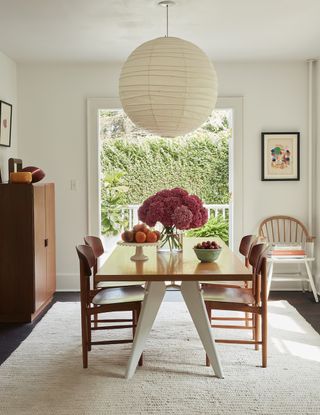
Layered lighting is key to setting the tone in your dining room, and it's something you should consider really early on in the design process. You'll need to include all three types among your dining room lighting ideas — task, accent, and ambient (with a heavy lean on the latter).
Consider adding a pendant light or chandelier to hang directly above the dining table, in a look that creates transitional-style dining rooms. Add a dimmable switch and these can provide both a strong task light and a softer ambient lighting. "It is best to position pendants around 25 inches from the table," advises Clotilde. "The distance is important because you don’t want to be able to see the bulb inside."
If you have surfaces around the room, dot smaller lamps on these to give a more general glow to the space. "Combine sidelights with feature lighting positioned to showcase art, a carefully curated bookcase or statement dining table," says Lucy St George, co-founder of Rockett St George. Sconces are a great choice, too, and we love these wireless ones from Pooky that are super easy to install.
10. Don't forget the small decor
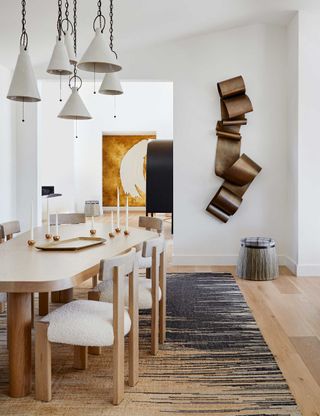
Unlike more relaxing rooms, it's easy to forget to add detail to dining rooms. Without shelving or purely decorative tabletops, it's hard to create a vignette that adds personality and nods to a cohesive design scheme. This is where smaller decor items come in.
"Table runners, place settings, and centerpieces are so personal to each client," says Lucy Small of State and Season. "I like to use the story and history, as well as setting, of each house to determine what their table decor and centerpieces should be. Coastal houses in Alabama will look very different from mountain houses in North Carolina, for example."
Consider seagrass placemats to make a dining room feel cozy, or taper candle holders dotted throughout for a more formal feel. It's these details that will help to tie a thread from your dining room through the rest of the house, too.

Price: $6
These woven placemats are perfect for everyday use, and they work especially well in a coastal themed home to add a warm and rustic touch.
11. Anchor the room with a pop of color
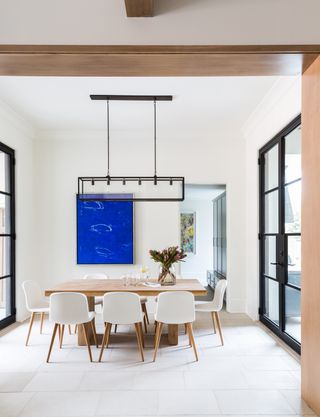
When planning your dining room ideas, a color scheme is an obvious place to start. If your dining room is multifunctional and doubles as a workspace, or it's your main dining space that the whole family uses daily, neutrals are a safe bet, helping to create a minimalist dining room. Pick creams, whites, greys and pale woods to create a room that feels calm and serene. At night, you can always up the intimacy by dimming the overhead lights and lighting taper candles.
And don't be afraid to add a pop of color in the form of artwork either. We love how the vivid pop of blue above adds an instant focal point to the space and grounds all the very light hues used throughout the rest of the room.
12. Add a wall covering
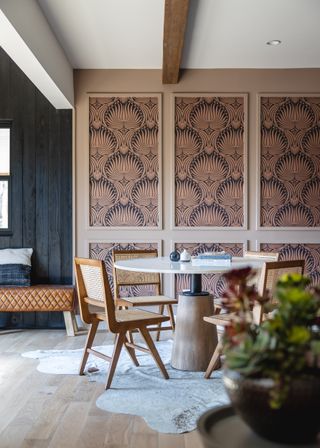
Want a dining room idea that's going to instantly make a statement? We are full advocates of dining room wallpaper can totally transform a room in just a few hours and you can go as dramatic or as subtle as you like with the print (although in a dining room, we say go bold!).
"Wallpapers in dining rooms work really well as they are such socializing areas so it's important to make them feel as welcoming, cozy, and interesting as we possibly can," explains Abigail Ahern. "From geometrics to graphics, to florals to contemporary abstract patterns to all sorts of wonderous finishes, the wallpaper will add a lot of dimension to this space and instantly transform the ambiance."
Don't be afraid to think outside the box with your dining room wall ideas, either. "Dining rooms are a great place to get expressive," Lucy reminds us. "You can add molding, wallpaper, texture, or all three to create a unique space."
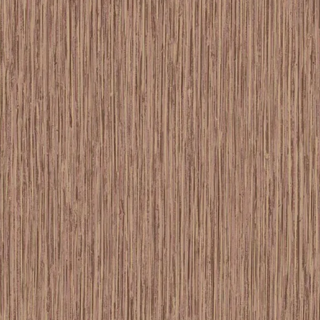
Priced from: $28 / roll
Both Abigail and Lucy are big fans of texture wallpaper in living rooms. While this faux grasscloth wallpaper might not be suitable for a high-traffic area like a kitchen, it will make your dining room feel so cozy and relaxed.
13. Squeeze in extra seating with a banquette
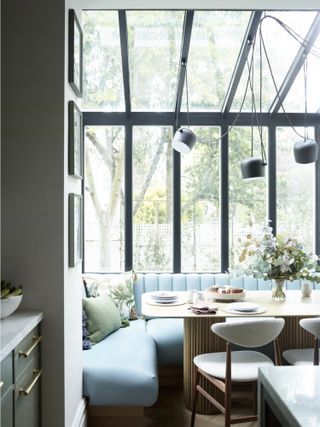
Switching out chairs for benches — or, even better, built-in banquette seating — is ideal for adding extra seating to a small dining room. Choose a design that hugs the wall and add storage under the bench to maximize every inch.
"Benches are ideal if you want to reconfigure the room for a bigger party, offering laid-back seating for many," says Victoria Atkin, co-founder of Atkin and Thyme. "If you’re more into upholstered dining chairs, look into smart, stain-proofed fabrics to keep them looking pristine."
Irene Gunter of interior design studio Gunter & Co. uses it in several of her projects, including the one pictured above. "We extended the rear of this Notting Hill apartment kitchen to create a snug spot for informal dining," she says. "A space-saving banquette covered in blue faux leather allowed us to squeeze more seating into the small area. We then added a bespoke dining table with a solid oak worktop that is gently chamfered and curved to avoid any awkward bumps when getting in and out of the banquette area."
14. Or add a dining sofa for a relaxed vibe
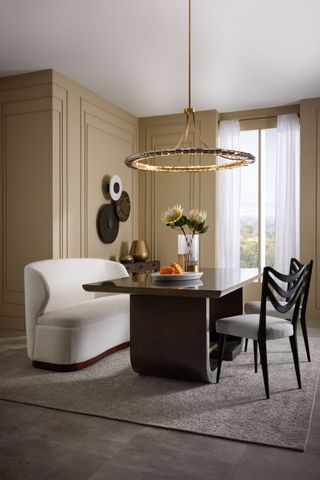
A modern dining room needn't be conventional when it comes to furniture. Recently, we've seen designers really dialing down formality with dining sofas which add a communal quality to a dining area and create an interesting asymmetry.
"These blend the comfort of a lounge area with the practicality of a dining space," Nina explains. "Opt for a plush, upholstered sofa in a durable fabric to accommodate long, leisurely meals and gatherings. To keep it cohesive, match the fabric to other textures in the room, like your curtains or rug, and add scatter cushions for extra coziness."
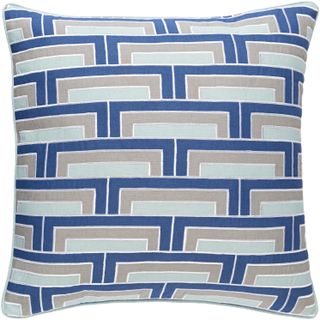
Price: $12.99
Dining rooms often lack soft textiles, but a dining sofa offers the chance to add some upholstery and layer even more pattern with throw pillows. This geometric pillow cover feels so 70s-inspired and would work brilliantly with matching curtains in a different colorway.
15. Fill a dining room with natural light
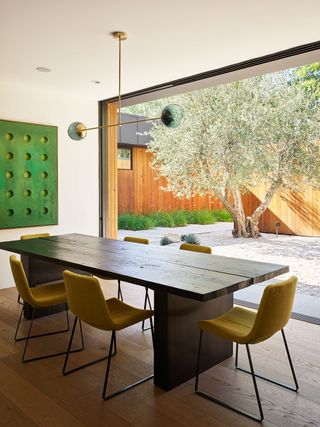
When it comes to dining rooms, artificial light is heavily relied on for creating ambiance. But these spaces aren't only reserved for evening entertaining, so consider where natural light will come from too. A picture window — or, even better, sliding glass doors — will instantly fill a space with light, making it the perfect place for sunny breakfasts and lunches as well as atmospheric dinners.
And when light floods in so beautifully, as with this dining room where there's that seamless flow between indoors and out, keeps the space itself simple. Lean on natural materials like wood and concrete and don't overcrowd the room with furniture. A large, minimalist dining table sat in the center of the space, with contemporary sculptural chairs and maybe a single piece of statement artwork really is all you need.
16. Use a simple sideboard for extra storage
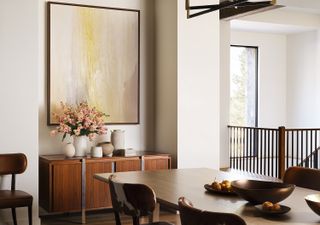
Storage can be key to a dining room, especially if you want space for glassware and some extra surface space for keeping drinks so you don't have to constantly be traipsing back to the kitchen for top-ups. A console table is the perfect dining room storage decor piece — elegant, slimline, and just the right amount of retro.
"They provide the perfect space for storing serveware as opposed to cramming things into a kitchen cabinet," says Sam Greig, lead designer at furniture brand, Swoon. "Ideally, the sideboard should be slightly taller than your dining table, for both ease and appearance." You could even copy this dining room idea and lose the legs and wall mount a sideboard, that way it doesn't break up the floor space and the room appears larger.
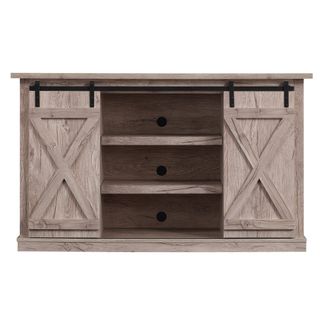
Price: $159.99
This spacious sideboard has space for plates and glassware, and the sliding doors keep everything hidden. Add a vase of fresh flowers and a carafe of water to the top and you're ready to welcome guests into your dining room.
17. Use dining chairs to lift a neutral scheme
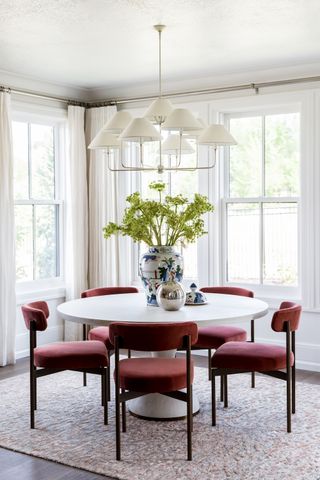
Much like artwork, dining chairs can be a simple way to add a splash of color to a dining room. Plus, if you are lucky enough to have the space and storage, you could have a few sets of dining room chairs you rotate throughout the year. If you keep the rest of the space neutral you don't have to worry about whether the chairs will work either so you can easily switch up the look and feel of the room with the seasons without having to totally redecorate.
The gorgeous wine-colored velvet chairs above would be perfect for autumn and winter, and then come spring you could switch them out for something softer and airier, like cane chairs.
18. Mix and match materials
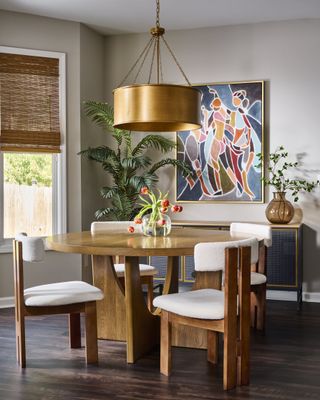
We all know matchy-matchy is a thing of the past, and that extends to material. The most contemporary dining spaces contrast furniture pieces and hardware accents to bring hard and soft finishes into the scheme.
"First to mind for a modern dining scheme is materiality," says Gianpiero Gaglione, owner and principal designer of Gianpiero Gaglione Interior Design. "You could say a traditional dining table would be wood or stone, whereas to create a contemporary feel, you could lean on materials like glass or Corian." Gianpiero recommends opting for high gloss or sharp edges to keep the piece contemporary, and if you want to incorporate metals, he suggests anything with a polished look. "Polished brass, polished chrome, polished copper. Any of these can evoke a glamorous and futuristic look," he says.
"Even table legs tell a story," adds Lucy. "A live edge oak table vs. an iron riveted table make a world of difference in a home and adds to its style." Dining table trends aside, be sure to juxtapose high sheens with matt surfaces, metallic finishes with wood or stone, and soft textiles with firm ones. This will make for a more balanced and cohesive dining room.
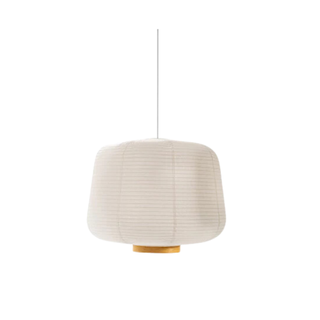
Price: $225
We love how this classic rice paper shade mixes in a wooden finish to mix materials and add detail to a minute design element. Use the same tricks throughout the rest of your dining room and it will look far more cohesive.
19. Go for an elegant all white color scheme
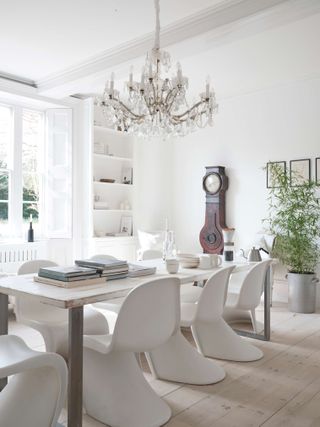
You really can't go wrong with an all-white scheme in a dining room. It's a classic look that's never going to date and works at any time of day in any lighting. You can always switch the atmosphere from crisp and clean to cozy and intimate by lighting candles and can easily add pops of other colors too if you want a bolder look. Although, we think the totally white palette of this dining room is bold; despite the lack of color, it still feels dramatic.
20. Embrace small proportion with darker hues
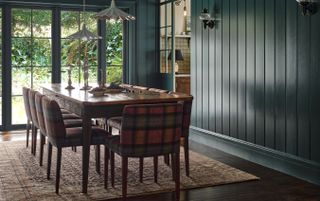
Should a dining room be painted light or dark? The point above might have swayed you in one direction, but that pendulum might switch the other way if you have a small dining room. We always say it's a myth that lighter colors are best for small spaces. We're firm believers that sometimes you are best to embrace a room's small proportions and make it cozy and cocooning with a dark color palette. And this is particularly true of dining rooms where you often want the space to feel dramatic and atmospheric.
"Cozy snugs, intimate dining rooms, and pint-sized rooms can lend themselves to a strong color palette, especially when they don’t benefit from a huge amount of natural light," says Helen Shaw, Director of Color Marketing at Benjamin Moore. "Dousing the rooms from floor to ceiling in rich colors can look particularly striking and a real benefit of a north-facing room is that you can play with light sources to create a certain mood and ambiance."
21. Experiment with contrasting shapes
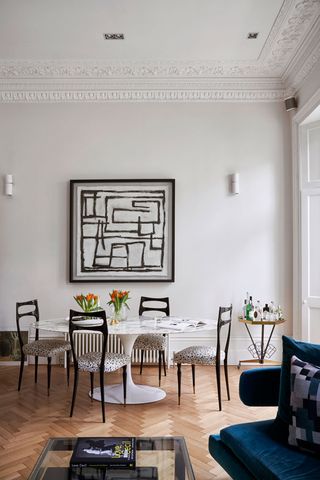
If you can't decide between an oval or rectangular dining table, think about the other shapes elsewhere in your space. Are there more curves or more clean lines? Whatever the answer, use your dining table as a point of contrast. Designers love mixing exaggerated organic shapes or unequal proportions with more classic angular lines, and it offers a real feast for the eyes.
For example, there's something really striking and elegant about the dining space above despite it being super simple. The mix of the soft curves of the circular, oversized marble-effect table and the bold dark lines of the chairs and artworks seem to mirror one another. It's a very balanced space, with a high contrast and a very clean look that makes the dining room look more expensive.
22. Add instant texture and interest with a gallery wall
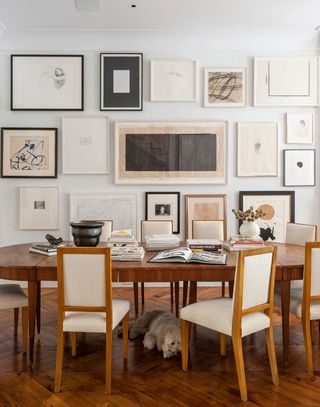
Gallery walls are the perfect way to bring personality, color, and texture into a dining room without cluttering up the floor, and they can be so much more interesting than a rigid grid of prints. You can mix and match frames, hang them in an asymmetrical pattern, and add in objects too to give it a more 3D effect.
"Opt for a variety of different frames rather than sticking rigidly to one color or finish," suggests Jane of Rockett St George. "This looks more interesting and gives you the freedom to add different frames as your collection grows."
She suggests planning ahead, too. "Before hanging anything on the wall, layout your frames on the floor to devise a layout and make sure they work well together," says Jane. "Art doesn’t have to cost a fortune, there are so many amazing and inexpensive ways to expand your gallery wall; from introducing your favorite family photos, to framing postcards, notes, finished puzzles, magazine covers, and beautiful playing cards."
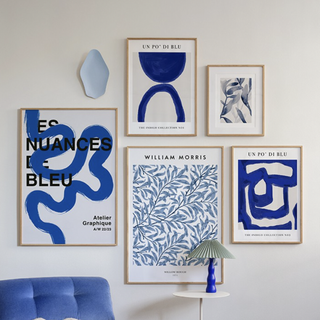
Price: $431.50
Lost on where to start with your gallery wall? This starter kit from Desenio comes with five frames and five blue-themed posters in various sizes to get you started.
23. Ground a dining room table with a rug
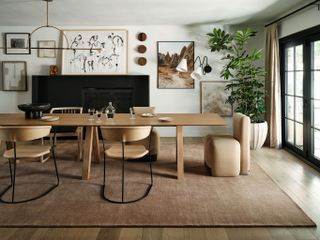
Hard floors make sense in a dining room. They are high-traffic areas that will usually see plenty of splashes and stains. However, hard floors don't offer that coziness or softness underfoot, so we'd recommend placing a large area rug under your dining table and chairs to ground the furniture — this works particularly well in open-plan kitchen diners to zone the areas.
"Go for a bold pattern, like Moroccan or geometric, to anchor the space and add visual interest, or a solid, plush option to keep the focus on the furniture," says Nina. "Make sure the rug is big enough for chairs to sit comfortably on when pulled out, so your dining experience feels both stylish and practical."
You should also pick a rug made from something hardwearing and stain-resistant (or one that won't show stains that easily). Rattan and jute are good options. "I always prefer to define the dining area with a flatweave rug or sisal," says Sabrina Albanese of Sabrina Albanese Interiors. "This isn’t necessarily to make the space feel warmer, but allows you to define the area — especially important if you are working with an open-concept space."
FAQs
What should you put in a dining room?
Wondering what to put in a dining room besides a table? Let your main furniture items dictate the layout and the rest of the decor, too. "Always consider space and how many seats are required," says Sabrina. "If the space is small, I usually use skinny, armless dining chairs, no wider than 17”. This allows for more chairs and scales to the room accordingly."
As a general rule, circular dining tables tend to work better in smaller spaces as you can be more flexible with where you place the seating and long rectangular tables work best in lofty dining rooms for an elegant feel.
If you have the space, you might want to add in some storage. A console table or a dresser can be a nice addition to a dining room, providing space for drinks and extra tableware. You can then add a few decorative pieces on the top such as a vase, or some coffee table books. Pepper with some artwork on the walls, a rug underfoot, and a few taper candles on the dining table and your space will look beautifully well-rounded.
What color is best for a dining room?
The best color for a dining room will depend on the size and aspect of your space, plus the overall feel you want to go for. Do you want light and airy or dark and dramatic? Think about how and who and when you use the room most as this will help you choose the best color.
For dining rooms that are solely used for entertaining and dinner parties, going dark would guarantee ambiance and look wonderful under low lighting or candlelight. Dark blues, rich reds, or even charcoal black would all suit that brooding, sophisticated vibe.
If you often use the space to host lunches, or if it's your main dining space, you might want to consider going more subtle. Whites, creams or pale pinks would all create a lovely warm, neutral space that would work at any time of day under any lighting.
Be The First To Know
The Livingetc newsletter is your shortcut to the now and the next in home design. Subscribe today to receive a stunning free 200-page book of the best homes from around the world.

Lilith Hudson is a freelance writer and regular contributor to Livingetc. She holds an MA in Magazine Journalism from City, University of London, and has written for various titles including Homes & Gardens, House Beautiful, Advnture, the Saturday Times Magazine, Evening Standard, DJ Mag, Metro, and The Simple Things Magazine.
Prior to going freelance, Lilith was the News and Trends Editor at Livingetc. It was a role that helped her develop a keen eye for spotting all the latest micro-trends, interior hacks, and viral decor must-haves you need in your home. With a constant ear to the ground on the design scene, she's ahead of the curve when it comes to the latest color that's sweeping interiors or the hot new style to decorate our homes.
- Hebe HattonFormer Digital Editor
-
 This Strangely-Shaped Side-Sleeper Pillow Is Going Viral for Super-Charging Beauty Sleep — And Preventing Wrinkles
This Strangely-Shaped Side-Sleeper Pillow Is Going Viral for Super-Charging Beauty Sleep — And Preventing WrinklesThis silk-wrapped, ergonomically designed pillow is winning over wellness gurus — and its unusual shape might be the secret to waking up flawless
By Julia Demer Published
-
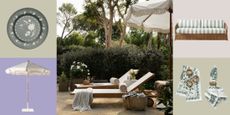 McGee & Co’s Outdoor 2025 Collection Is Designed to Survive Whatever Life Throws at It — Yes, Even Red Wine
McGee & Co’s Outdoor 2025 Collection Is Designed to Survive Whatever Life Throws at It — Yes, Even Red WineSun, rain, working from home, and the occasional spilled glass? No problem. This outdoor collection makes an oasis out of everyday obstacles
By Julia Demer Published
-
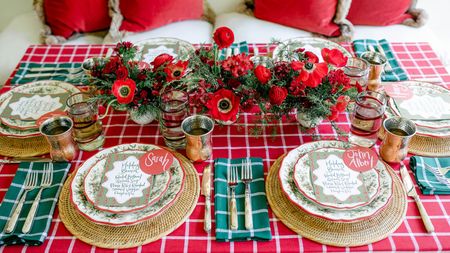 How to Set a Table — For the Holidays, Special Occasions or Just a Casual But Classy Lunch
How to Set a Table — For the Holidays, Special Occasions or Just a Casual But Classy LunchWhether you are going formal or casual, these table setting tips from design experts will help you get your dinner party set up just right
By Olivia Wolfe Published
-
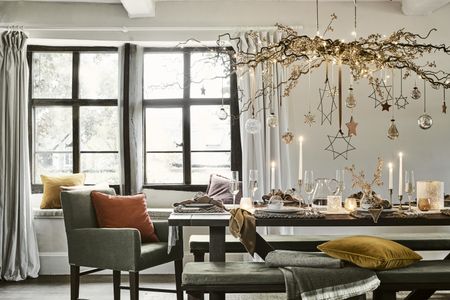 If You’re Planning a Holiday Centerpiece to Run Along Your Table, You’re Doing it Wrong — Here’s Why
If You’re Planning a Holiday Centerpiece to Run Along Your Table, You’re Doing it Wrong — Here’s WhyWe've come up with a whimsical new idea that is sure to "elevate" your centerpiece this festive season
By Olivia Wolfe Published
-
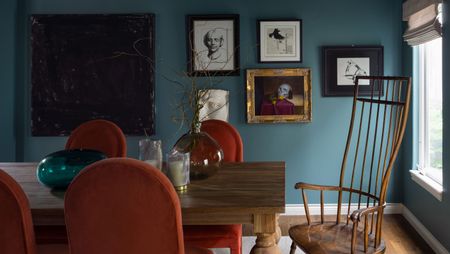 11 Blue Dining Room Ideas That Prove This Palette Is the Restful Shade You Want for Entertaining
11 Blue Dining Room Ideas That Prove This Palette Is the Restful Shade You Want for EntertainingWe've curated a round up of designer projects that all use shades of blue in dining spaces to beautiful effect
By Portia Carroll Published
-
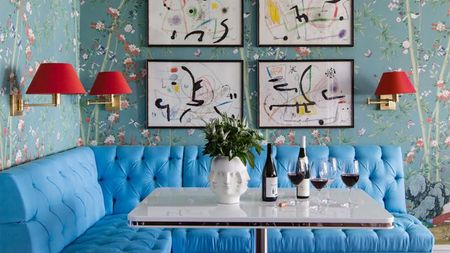 Dining room wall ideas to set the mood for relaxing and entertaining
Dining room wall ideas to set the mood for relaxing and entertainingGet your guests talking with dining room wall ideas that are guaranteed to grab the attention, from hand-painted murals to flamboyant wallpapers
By Keith Flanagan Last updated
-
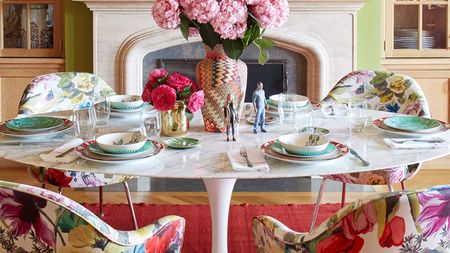 Dining table ideas to elevate your decor out of the ordinary
Dining table ideas to elevate your decor out of the ordinaryThe latest dining table ideas that show interior designers are bringing new shapes and styles to the table
By Keith Flanagan Last updated
-
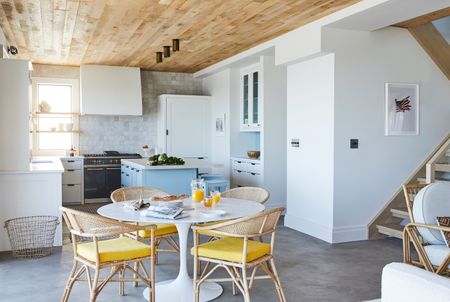 10 kitchen diner ideas – how to create a stylish and functional open plan space
10 kitchen diner ideas – how to create a stylish and functional open plan spaceLet these kitchen diner ideas help you design the dream space to cook, dine and entertain...
By Hebe Hatton Last updated
-
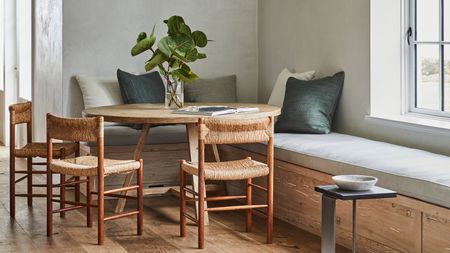 14 small dining room ideas – chic and clever ways to make the most of your space
14 small dining room ideas – chic and clever ways to make the most of your spaceThese small dining room ideas prove that limited square footage needn't limit your style
By Lotte Brouwer Last updated
-
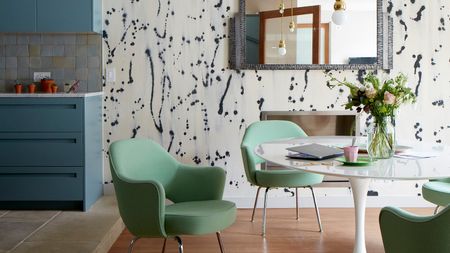 10 dining room wallpaper ideas – modern murals, quirky prints and subtle styles tp update your space
10 dining room wallpaper ideas – modern murals, quirky prints and subtle styles tp update your spaceAdding pattern, texture, and personality, these dining room wallpaper ideas are sure to impress your guests
By Hebe Hatton Last updated


